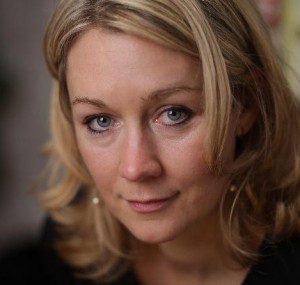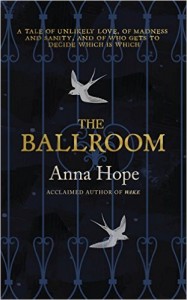The Ballroom

Photo by Jonathon Greet 2014
The seed of The Ballroom was a tiny, almost crossed-out note in the corner of the 1911 census; ‘all are there,’ it read, ‘except the father, who is in Menston Asylum.’
The father in question was my great-great-grandfather, an Irishman who had settled in Bradford, married and had a child. Immediately intrigued and knowing nothing about my ancestor’s life or the asylum in question, I searched online and came across a fascinating online archive dedicated to the institution that opened in the mid 19th century as West Riding Pauper Lunatic Asylum, later becoming Menston Asylum and then High Royds Hospital, before closing its doors in 2003.
The asylum looked as I imagined it should: huge, forbidding and bleak, but as I searched further on the site I came across photographs of something surprising, a spectacular, ruined ballroom at the building’s heart. The contrast between this beautiful room with its stained glass windows, sprung dance floor and stage, a place, I learned, where the patients would meet to dance on a Friday night, and the darkness that surrounded it, captivated me. It raised all sorts of questions about the attitudes of those who had built it, and the life of those who met there, and I knew I had to write about it.
 I knew from that start that The Ballroom would be a love story, the magnificent ballroom just seemed to call out for it. It’s always dramatically interesting too to explore obstacles to love, and the asylum setting presented plenty of those. Originally I planned to trace the love of a couple over many years; a sort of anti-history of the 20th century in which the seismic changes outside the asylum’s walls have little impact, but I soon began to see that was too ambitious, too meandering.
I knew from that start that The Ballroom would be a love story, the magnificent ballroom just seemed to call out for it. It’s always dramatically interesting too to explore obstacles to love, and the asylum setting presented plenty of those. Originally I planned to trace the love of a couple over many years; a sort of anti-history of the 20th century in which the seismic changes outside the asylum’s walls have little impact, but I soon began to see that was too ambitious, too meandering.
My first book, Wake, was set over five days and I like a structure that forces me to think within a tight time frame, so when in the course of my research I learned about the heatwave summer of 1911, a time of industrial unrest in which the temperature hardly dropped below 33 degrees for five months, I knew I wanted to set the novel then. It’s a book that deals with love, madness, sensuality, forbidden desires and our relationship with the natural world and so to set it in a time of such extreme weather felt appropriate and exciting.
It seemed a fascinating period too, in which to explore the theme of eugenics and social control; Churchill was Home Secretary with plenty of troubling ideas about how to deal with the issue of the ‘feeble minded,’ and a huge amount on his hands with the emerging trade union movement flexing its muscles, as well as the suffragettes. I liked the idea that this exterior turbulence might find its way into the book obliquely, just as the heat seeps into the asylum’s walls and wards.
Research was wide-ranging, from reading the original casebooks in the asylum’s archives to visits to the Wellcome Collection where they hold the journal of the Eugenics Society, both of which made for fascinating and troubling reading. The casebooks were potent, with their marbled covers, smell of age and photographs of the patients.
Often, while I read, the voices of those patients would erupt vividly from the pages, even if couched in a doctor’s handwriting, seeming to insist on making themselves heard. I went to the Churchill archives, held at Churchill College in Cambridge, hoping for a glimpse into the mind of a man whose language at the time, in its insistence on the threat to the race of the feeble minded and socially degenerate seemed to prefigure that of his great enemy a few decades later.
Discovering this side to Churchill was shocking, but it’s easy to demonise him, in fact his views were shared by people across the political spectrum, from George Bernard Shaw, to the Fabians Sidney and Beatrice Webb and society figures like Ottoline Morrell; so many people, it seemed, before the First World War, were pro-eugenics.
Character is hugely important to me, although I don’t seem to see my characters, physically at least, I feel them instead; each has a pulse, a rhythm. Writing in close third person for Ella, John and Charles, I wanted each of their sections to reflect their voice, to carry their energetic stamp.
John was inspired by the story of my great-great-grandfather, and I took many of the biographical details of his life; coming from the west of Ireland to find work in Liverpool as a young man, his ‘melancholia,’ his refusal to speak when arriving in the asylum and used them for the character of John in the book, but I also always knew I wanted to have the freedom of fiction in creating the John of the book. Similarly I re-named the asylum Sharston so I might have the greater latitude there that fictionalisation allows.
Landscape too, was always vital for this novel; I grew up not far from where the novel is set, on the other side of the Pennines in Lancashire, and the contrast between those dark, industrial towns and the wild country all around them was a feature of my childhood and, I think, a primary influence on my writing. It was always important to me that this was a story of confinement and escape, and to explore how the natural world might facilitate and echo the characters’ desire for freedom in their lives.
—
Category: On Writing
Comments (4)
Trackback URL | Comments RSS Feed
Sites That Link to this Post
- The New Thirst For Words : Women Writers, Women's Books | July 15, 2016































Anna, what a fascinating topic! I’m beginning my second novel, initially set around the same time period, but about a different program in which children from impoverished families in city slums were taken from their parents, put in “homes”, and then shipped off to Canada, Australia, or even South Africa, often without the parents’ knowledge. It was commonly believed that the poor were mentally and physically inferior, and their uncontrolled “breeding” was going to weaken the British race. Churchill merely believed what everyone else believed; he was not in any way unique, and Darwin’s theories supported it. I’m going to read your book, and I hope when mine comes out (it will be awhile) you will read mine too. Best of success to you.
This book intrigues me. Such an original approach to writing a novel! I’ll look for it. Thanks.
Anna,
Your book sounds wonderful; I was hooked by the description of the ruined ballroom. And all the contrasts intrigue me — ballroom/ asylum; industrial town / wild countryside. Richard Russo wrote a great essay on setting (I think it’s called “Location Location Location” -!), which made me think about all the settings in the novels I love.
Good luck with your book launch! I’m excited to start reading.
Martha Conway